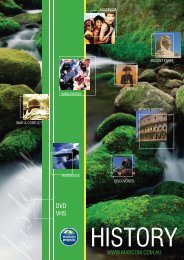Water Cycle - Marcom Projects
Water Cycle - Marcom Projects
Water Cycle - Marcom Projects
You also want an ePaper? Increase the reach of your titles
YUMPU automatically turns print PDFs into web optimized ePapers that Google loves.
Name<br />
18<br />
<strong>Water</strong> Fill-In<br />
Use what you have learned to label the diagram below. Use the definitions at the<br />
bottom of the page if needed.<br />
After Viewing<br />
Activity 1<br />
Accumulation – The process in which water pools in large bodies (like oceans, seas<br />
and lakes).<br />
Condensation – The process in which water vapor (a gas) in the air turns into liquid<br />
water. Condensing water forms clouds in the sky. <strong>Water</strong> drops that form on the outside<br />
of a glass of icy water are condensed water. (This term appears twice in the diagram.)<br />
Evaporation – The process in which liquid water becomes water vapor (a gas). <strong>Water</strong><br />
vaporizes from the surfaces of oceans and lakes, from the surface of the land, and from<br />
melts in snow fields.<br />
Precipitation – The process in which water (in the form of rain, snow, sleet, or hail)<br />
falls from clouds in the sky.<br />
Subsurface Runoff – Rain, snowmelt, or other water that flows in underground<br />
streams, drains, or sewers.<br />
Surface Runoff – Rain, snowmelt, or other water that flows in surface streams, rivers,<br />
or canals.<br />
Transpiration – The process in which some water within plants evaporates into the<br />
atmosphere. <strong>Water</strong> is first absorbed by the plant’s roots, then later exits by evaporating<br />
through pores in the plant.<br />
<strong>Water</strong> <strong>Cycle</strong> Video Quiz © Sunburst Visual Media, a division of Global Video, LLC











